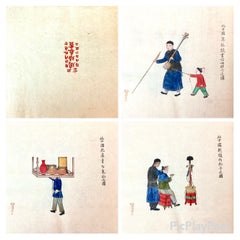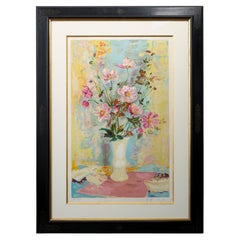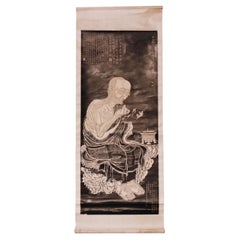J & M Antiques Prints
to
1
1
1
1
1
1
1
1
1
1
Antique Album Of Chinese Gouache Paintings On Paper
Located in Bradenton, FL
Rare Chinese Export School. 24 miniatures in watercolor and bodycolor on pith paper. Album of pith paintings depicting trades and professions. 19th century Chinese, bound with silk t...
Category
Antique 19th Century Chinese Chinese Export Prints
Materials
Paper
Related Items
Exceptional Le Pho Lithograph on Vellum Paper
By Lê Phổ
Located in Jersey City, NJ
Le Pho was a Vietnamese painter (1907-20010 who is now internationally known. He painted scenery of Vietnam, still life with flowers, family setting...
Category
Vintage 1960s French Prints
Materials
Paper, Wood
Antique Chinese Printed Ink Rubbing of Panthaka Arhat, (scroll mounted)
Located in Point Richmond, CA
Chinese ink rubbing printing depicting Panthaka Arhat, no.4 of the 16 arhat images immortalized in stone at the former stupa at Shengyin Temple. Depicted here sitting on a rock with a book in his left hand and snapping his fingers in his right hand, symbolic of the speed at which he obtained enlightenment, accompanied by a beggar’s bowl and an incense burner, complete with colophons and silk scroll mounting. The Emperor Qianlong ordered the stone stele to be carved in 1764 after the arhat designs painted by the famed artist Guanxiu (832-912). Even though the temple was destroyed in the Taiping rebellion, the steles remain and have been reinstalled at the Hangzhou Stele Forest. Condition: Creases from rolling, otherwise fine condition. Mounting: 58” x 22”. 19th Century. Ex Collection: Frank “Till” & Peggy Durdin, San Diego.
For other rubbings of this stele see:
Penn Museum, object number 2010-26-4
The Metropolitan Museum of Art AN#: 59.195.15
Fine Arts Library of Harvard University, record id: W280021_urn-3:FHCL:478850
For another example of this image rendered in jade and lacquer see: “Screen Paintings of Guanxiu’s Sixteen Arhats in the Collection of the Palace Museum” Luo Wehhua translated by Bruce Doar, Orientations, September 2010, p. 104. In this article the image is identified as the sixteenth arhat Abheda, It is explained in this article that Qianlong re-identified the arhats, thus the 16th Arhat attribution for this image. Also in this article the identical colophon by Qianlong above the image is translated as: “These accurate portraits of the Sixteen Arhats were created by the Tang Dynasty painter Guanxiu, as recorded in Xuanhe Huapu (Record of paintings in the Xuanhe Reign), and during the millennium from the Guangming reign period to the present day, the original works were to be found in Zhejiang, where they were housed in the collection of Shengyin Temple in Qiantang (Huangzhou). In spring of the dingchou year (1757) of his reign, the Qianlong emperor undertook a southern tour of inspection and stayed at an imperial lodge on the West Lake. He went to the temple to pay his respects and there he saw the arhats on display and wrote a description of these marvels. The sequence of the arhats and their names had been passed down since ancient times, but they did not correspond to their Sanskrit titles; the sequence of the arhat names conformed instead to the interpretation of the Sanskrit classics by the Zhangjia State Preceptor. The emperor penned the original names and positions in the sequence below each of the figures in accordance with the readings supplied in Tongwen Yuntong (Unified Rhymes), and below each he penned an encomium, which he signed. Then the images were returned to the collection, to be passed down as a perpetual treasure. Now, the fourth great arhat had long gone missing and we did not know where his painting was. But it was merely a trifling matter of matching the images with the names, and now surely we have found him! This I, the emperor, believe.”
All 16 of these rubbings can be found in the Rubel Chinese Rubbings Collection at the Fine Arts Library of Harvard University with the following descriptive historical note: “Rubbing from stele depicting No. 4 of 16 arhats (Lohans, Buddhist saints) -- Nan ti mi duo luo qing you, Panthaka Arhat. Original painting attributed to Guanxiu, 832-912. Inscriptions written by Hongli, Emperor Qianlong (Gaozong, 1711-1799) of Qing Dynasty. 7 seals of Qianlong follow the inscriptions. Script style: in xing shu. Shi liu zun zhe -- "The 16 noble ones" are 16 lohans. Lohans are also called "a-lo-han" based on the transliteration of the Sanskrit term "arhat." (Japanese: Rakan; Chinese: Lohan; Tibetan: Gnas-brtan). Arhats or Arahants are saints or sages said to have renounced nirvana (freedom from the cycle of suffering and rebirth), vowed to remain in the world to protect the Dharma and propagate the Law of the Buddha in order to devote themselves more effectively to the relief of human misery, like the Bodhisattvas. These 16 Arhats, personal disciples distinguished by the Buddha, formed part of the 500 claimed by tradition to have attended the First Council in Rajagrha. The names and abodes of these 16 arhats are given in a work entitled "Record on the Duration of the Law, spoken by the Great arhat Nadimitra," which was translated into Chinese by the famous pilgrim Xuanzang (596-664) in 654. 16 lohans are quite often represented, especially in China and Japan, in sculpture and painting, in poses and with attributes. Every lohan can be easily with special icongraphic characteristics. Guanxiu (Jiang Deyin or Deyuan, a Buddhist monk also named Master Chan Yue, 832-912) -- painter during late Tang to Five Dynasties, specialized in painting lohan figures. Legend has it that the first portraits of the 18 Lohans...
Category
Antique 19th Century Chinese Qing Prints
Materials
Paper
Chinese Framed Print of Tang Dynasty Painting
By Han-Kan
Located in Savannah, GA
Chinese framed print detail of larger painting. Expertly framed with double mats of linen and simulated bamboo featuring gold leaf edging on both mats.
"Han-Kan Bringing Tribute" New...
Category
Antique 15th Century and Earlier Chinese Tang Prints
Materials
Chrome
Antique Japanese Painting Framed on Jute 'Lovers Dance'
Located in Milano, IT
Antique and very rare Japanese painting made in the early 1900s by a fine Japanese manufacturer.
The painting has a rectangular brass frame with rounded corners. Internally we see a...
Category
Antique Early 1900s Japanese Anglo-Japanese Prints
Materials
Brass
$380 Sale Price
20% Off
H 12.8 in W 10.04 in D 0.56 in
Mandarin Taoist Ceremonial Chinese Scroll Portrait Painting in Custom Frame
Located in Yonkers, NY
Mandarin Taoist Chinese ceremonial scroll portrait painting in custom plexiglass frame. Exuding an air of spiritual significance and artistic mastery, this Mandarin Taoist Chinese ce...
Category
Antique 19th Century Chinese Prints
Materials
Plexiglass, Paper
$1,800
H 51.75 in W 26.5 in D 1 in
Artisan's Cache of 25 Old Chinese Paint Calligraphy Bamboo Brushes
Located in South Burlington, VT
Here's a rare find from a collector we visited in Japan. A very unusual treasure....
This is a cache of old Chinese and Japanese bamboo paint and calligraphy artist brushes dating ...
Category
Mid-20th Century Chinese Showa Prints
Materials
Bamboo
$156 Sale Price
20% Off
H 0.3 in W 10 in D 0.3 in
Antique Japanese Brass Painting 'Romantic Serenade'
Located in Milano, IT
Ancient and very rare Japanese painting made in the early 1900s of fine Japanese manufacture. The painting has a rectangular brass frame, with rounded corners. Internally we see an a...
Category
Antique Early 1900s Japanese Anglo-Japanese Paintings and Screens
Materials
Brass
$380 Sale Price
20% Off
H 12.8 in W 10.04 in D 0.56 in
Original Poster Pablo Picasso, 67 Acuarelas, Dibujos, Gouaches, Sala Gaspar
By Pablo Picasso
Located in Barcelona, ES
Original Poster – Pablo Picasso, 67 Acuarelas, Dibujos, Gouaches, Sala Gaspar, 1974
Description:
Details:
Artist: Pablo Picasso
Exhibition: 67 Acuarelas, Dibujos, Gouaches de 18...
Category
Vintage 1970s Spanish Mid-Century Modern Prints
Materials
Paper
$588 Sale Price
44% Off
H 27.56 in W 19.69 in D 0.04 in
Chinese Silk Hanging Scroll with Original Gold Lined Box
Located in Miami, FL
Beautiful Chinese silk scroll painting of a peacock surrounded by stunning foliage with calligraphy on the upper left side.
Housed in its original...
Category
Late 20th Century Chinese Chinese Export Prints
Materials
Silk
$675 Sale Price
24% Off
H 42.88 in W 11.38 in D 1.38 in
Antique Two Framed Paintings of Japanese Processions, Signed
Located in Norton, MA
Antique Two Framed Paintings of Japanese Processions, pigment on silk and the artist signed on both paintings.
Category
Antique 19th Century Japanese Prints
Materials
Silk, Paper
Antique Hand Colored Print of Chinese Life
Located in Rochester, NY
Early 19th century hand colored engraving of Chinese life. Original print from "The punishments of China" illustrated by twenty-two engravings by Mason, George Henry; Dadley, J. P. P...
Category
Antique Early 19th Century Prints
Materials
Paint, Paper
China Extraordinary Unique Lady In Pink Natural Stone Painting
Located in South Burlington, VT
Extraordinary natural work, one of a kind. Custom Chinese framed.
Rare red flower marble stone- a Chinese Favorite
This Chinese extraordinary natural stone "painting" of an ima...
Category
Late 20th Century Chinese Paintings and Screens
Materials
Marble
$3,040 Sale Price
36% Off
H 23.5 in W 28.75 in D 0.5 in


